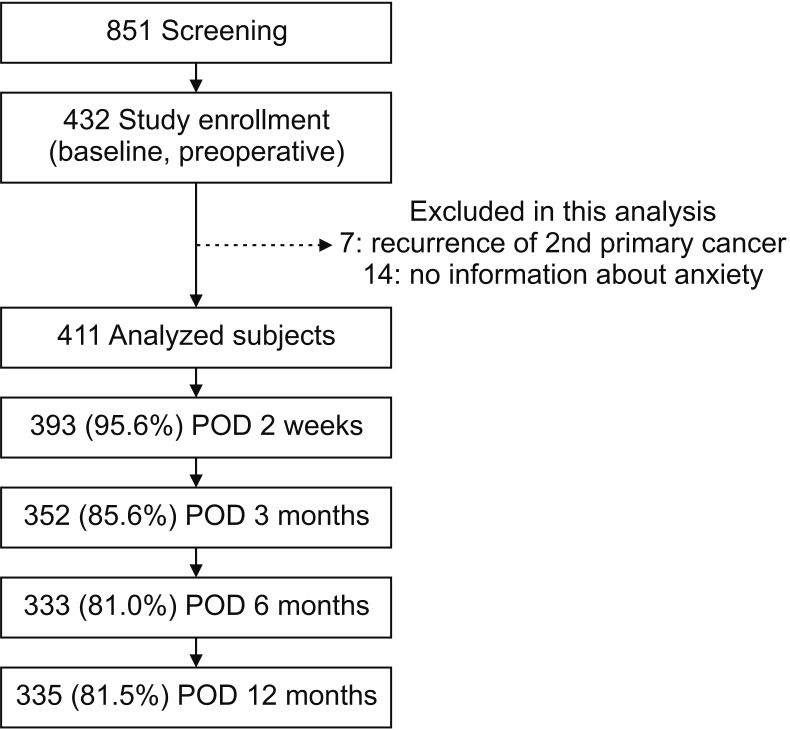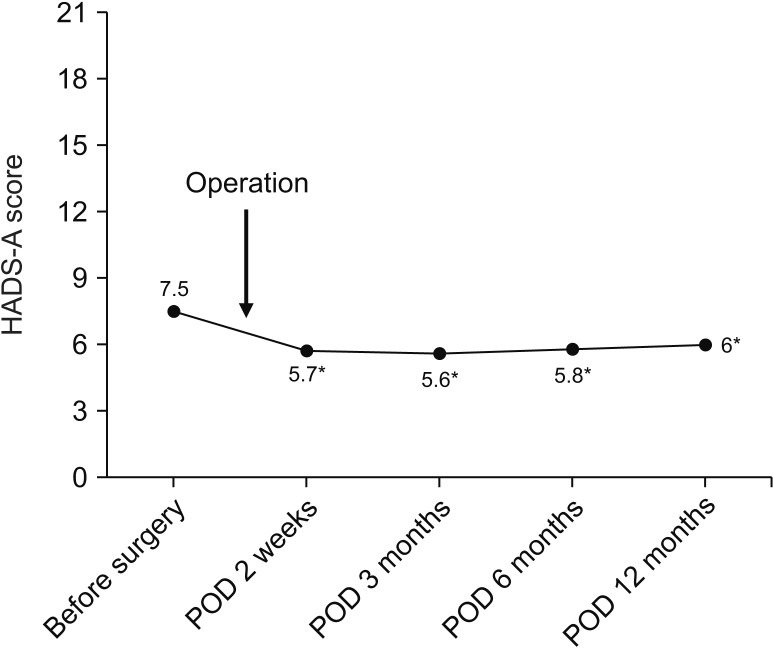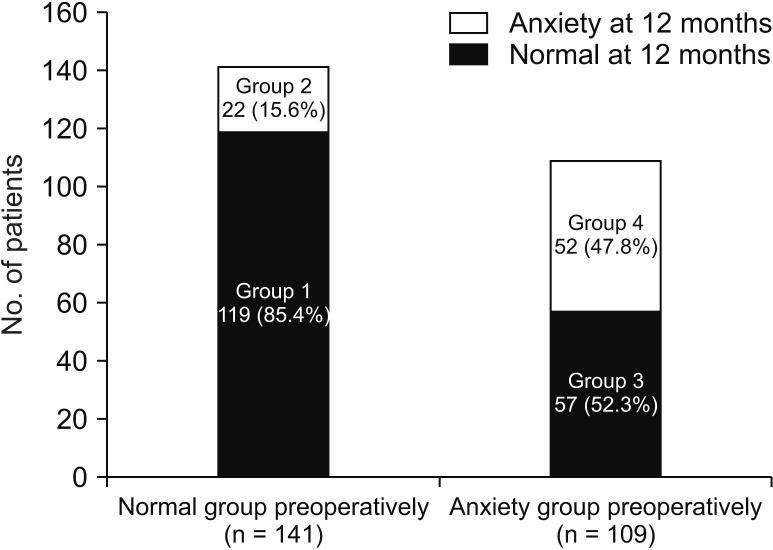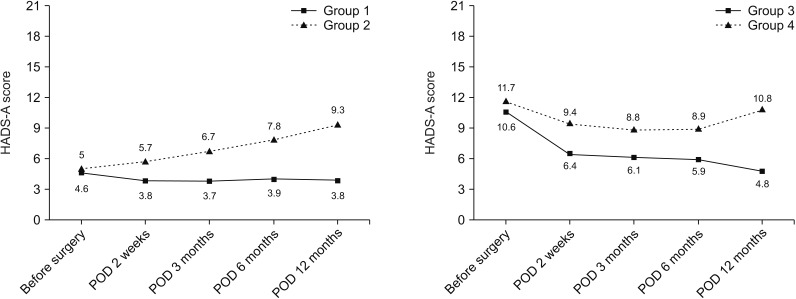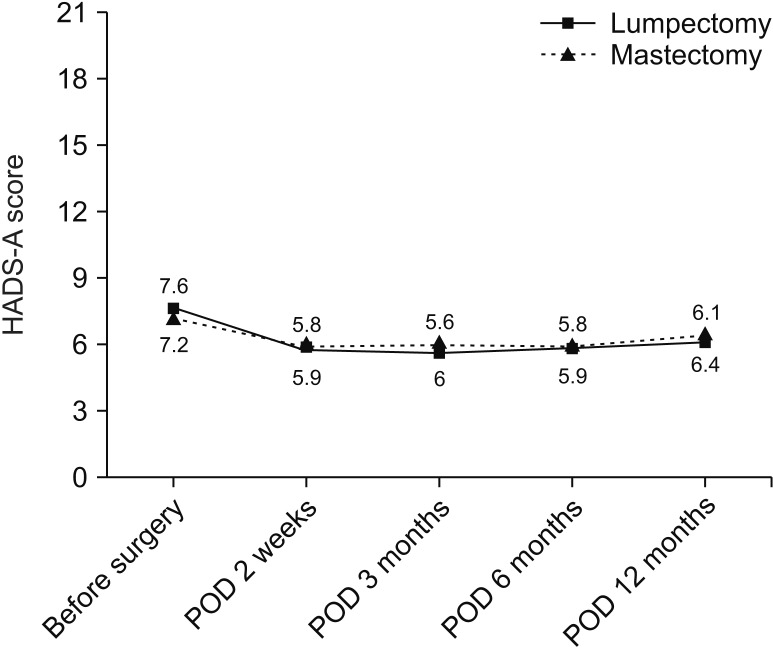Ann Surg Treat Res.
2020 May;98(5):215-223. 10.4174/astr.2020.98.5.215.
Surgical impact on anxiety of patients with breast cancer: 12-month follow-up prospective longitudinal study
- Affiliations
-
- 1Department of Surgery, Daerim St. Mary’s Hospital, Seoul, Korea
- 2Cancer Education Center, Samsung Comprehensive Cancer Center, Samsung Medical Center, Sungkyunkwan University School of Medicine, Seoul, Korea
- 3Department of Surgery, Samsung Medical Center, Sungkyunkwan University School of Medicine, Seoul, Korea
- KMID: 2500822
- DOI: http://doi.org/10.4174/astr.2020.98.5.215
Abstract
- Purpose
Breast cancer diagnosis and treatment often produce stress in patients. Anxiety is one of the most prevalent psychological symptoms perceived by breast cancer patients. This study aims to evaluate the temporal patterns of anxiety and find factors associated with persistent anxiety during breast cancer treatment.
Methods
This is prospective cohort study. Between July 2010 and July 2011, we recruited patients with nonmetastatic breast cancer who were expected to receive adjuvant chemotherapy (n = 411) from 2 cancer hospitals in Seoul, Korea. Anxiety was measured using the Hospital Anxiety and Depression Scale.
Results
The mean age of the participants was 46.4 ± 7.9 years. Preoperatively, 44.5% (183 of 411) of the patients showed abnormal anxiety. The proportion of the abnormal anxiety group significantly decreased after surgery (P < 0.01) and this phenomenon continued until the 12-month follow-up point. Patients experienced renewed anxiety at 12 months when the main adjuvant therapies were finished. Socioeconomic factors were not associated with persistent anxiety. Pain, breast, and arm symptoms were significantly higher in the persistently abnormal group, especially at postoperative months 6 and 12.
Conclusion
Surgery was a major relieving factor of anxiety, and patients who finished their main adjuvant treatment experienced renewed anxiety. Surgeons should be the main detectors and care-givers with respect to psychological distress in breast cancer patients. To reduce persistent anxiety, caring for the patient’s physical symptoms is important.
Keyword
Figure
Reference
-
1. Stark D, Kiely M, Smith A, Velikova G, House A, Selby P. Anxiety disorders in cancer patients: their nature, associations, and relation to quality of life. J Clin Oncol. 2002; 20:3137–3148. PMID: 12118028.
Article2. Taira N, Shimozuma K, Shiroiwa T, Ohsumi S, Kuroi K, Saji S, et al. Associations among baseline variables, treatment-related factors and health-related quality of life 2 years after breast cancer surgery. Breast Cancer Res Treat. 2011; 128:735–747. PMID: 21681445.
Article3. DiMatteo MR, Lepper HS, Croghan TW. Depression is a risk factor for noncompliance with medical treatment: meta-analysis of the effects of anxiety and depression on patient adherence. Arch Intern Med. 2000; 160:2101–2107. PMID: 10904452.4. Greer JA, Pirl WF, Park ER, Lynch TJ, Temel JS. Behavioral and psychological predictors of chemotherapy adherence in patients with advanced non-small cell lung cancer. J Psychosom Res. 2008; 65:549–552. PMID: 19027443.
Article5. Groenvold M, Petersen MA, Idler E, Bjorner JB, Fayers PM, Mouridsen HT. Psychological distress and fatigue predicted recurrence and survival in primary breast cancer patients. Breast Cancer Res Treat. 2007; 105:209–219. PMID: 17203386.
Article6. Montazeri A. Quality of life data as prognostic indicators of survival in cancer patients: an overview of the literature from 1982 to 2008. Health Qual Life Outcomes. 2009; 7:102. PMID: 20030832.
Article7. Satin JR, Linden W, Phillips MJ. Depression as a predictor of disease progression and mortality in cancer pat ients: a meta-analysis. Cancer. 2009; 115:5349–5361. PMID: 19753617.8. Burgess C, Cornelius V, Love S, Graham J, Richards M, Ramirez A. Depression and anxiety in women with early breast cancer: five year observational cohort study. BMJ. 2005; 330:702. PMID: 15695497.
Article9. So WK, Marsh G, Ling WM, Leung FY, Lo JC, Yeung M, et al. Anxiety, depression and quality of life among Chinese breast cancer patients during adjuvant therapy. Eur J Oncol Nurs. 2010; 14:17–22. PMID: 19734087.
Article10. Ho SS, So WK, Leung DY, Lai ET, Chan CW. Anxiety, depression and quality of life in Chinese women with breast cancer during and after treatment: a comparative evaluation. Eur J Oncol Nurs. 2013; 17:877–882. PMID: 23727448.
Article11. Schubart JR, Emerich M, Farnan M, Stanley Smith J, Kauffman GL, Kass RB. Screening for psychological distress in surgical breast cancer patients. Ann Surg Oncol. 2014; 21:3348–3353. PMID: 25034820.
Article12. Saboonchi F, Petersson LM, Wennman-Larsen A, Alexanderson K, Brannstrom R, Vaez M. Changes in caseness of anxiety and depression in breast cancer patients during the first year following surgery: patterns of transiency and severity of the distress response. Eur J Oncol Nurs. 2014; 18:598–604. PMID: 24997517.
Article13. Zigmond AS, Snaith RP. The hospital anxiety and depression scale. Acta Psychiatr Scand. 1983; 67:361–370. PMID: 6880820.
Article14. Bjelland I, Dahl AA, Haug TT, Neckelmann D. The validity of the hospital anxiety and depression scale. An updated literature review. J Psychosom Res. 2002; 52:69–77. PMID: 11832252.15. Oh SM, Min KJ, Park DB. A study on the standardization of the hospital anxiety and depression scale for koreans: a comparison of normal, depressed and anxious groups. J Korean Neuropsychiatr Assoc. 1999; 38:289–296.16. Sprangers MA, Groenvold M, Arraras JI, Franklin J, te Velde A, Muller M, et al. The European Organization for Research and Treatment of Cancer breast cancer-specific quality-of-life questionnaire module: first results from a three-country field study. J Clin Oncol. 1996; 14:2756–2768. PMID: 8874337.
Article17. Yun YH, Bae SH, Kang IO, Shin KH, Lee R, Kwon SI, et al. Cross-cultural application of the Korean version of the European Organization for Research and Treatment of Cancer (EORTC) Breast-Cancer-Specific Quality of Life Questionnaire (EORTC QLQ-BR23). Support Care Cancer. 2004; 12:441–445. PMID: 15088137.18. Boyes AW, Girgis A, D'Este CA, Zucca AC, Lecathelinais C, Carey ML. Prevalence and predictors of the short-term trajectory of anxiety and depression in the first year after a cancer diagnosis: a populationbased longitudinal study. J Clin Oncol. 2013; 31:2724–2729. PMID: 23775970.
Article19. Stafford L, Judd F, Gibson P, Komiti A, Mann GB, Quinn M. Anxiety and depression symptoms in the 2 years fol lowing diagnosis of breast or gynaecologic cancer: prevalence, course and determinants of outcome. Support Care Cancer. 2015; 23:2215–2224. PMID: 25559036.20. Kyranou M, Puntillo K, Dunn LB, Aouizerat BE, Paul SM, Cooper BA, et al. Predictors of initial levels and trajectories of anxiety in women before and for 6 months after breast cancer surgery. Cancer Nurs. 2014; 37:406–417. PMID: 24633334.
Article21. Henselmans I, Helgeson VS, Seltman H, de Vries J, Sanderman R, Ranchor AV. Identification and prediction of distress trajectories in the first year after a breast cancer diagnosis. Health Psychol. 2010; 29:160–168. PMID: 20230089.
Article22. Schwarz R, Krauss O, Hockel M, Meyer A, Zenger M, Hinz A. The course of anxiety and depression in patients with breast cancer and gynaecological cancer. Breast Care (Basel). 2008; 3:417–422. PMID: 21048913.
Article23. Karakoyun-Celik O, Gorken I, Sahin S, Orcin E, Alanyali H, Kinay M. Depression and anxiety levels in woman under follow-up for breast cancer: relationship to coping with cancer and quality of life. Med Oncol. 2010; 27:108–113. PMID: 19225913.
Article24. Koch L, Jansen L, Brenner H, Arndt V. Fear of recurrence and disease progression in long-term (≥ 5 years) cancer survivors--a systematic review of quantitative studies. Psychooncology. 2013; 22:1–11.25. Jefford M, Karahalios E, Pollard A, Baravelli C, Carey M, Franklin J, et al. Survivorship issues following treatment completion--results from focus groups with Australian cancer survivors and health professionals. J Cancer Surviv. 2008; 2:20–32. PMID: 18648984.
Article26. Yang H, Brand JS, Fang F, Chiesa F, Johansson AL, Hall P, et al. Time-dependent risk of depression, anxiety, and stress-related disorders in patients with invasive and in situ breast cancer. Int J Cancer. 2017; 140:841–852. PMID: 27859142.
- Full Text Links
- Actions
-
Cited
- CITED
-
- Close
- Share
- Similar articles
-
- Changes of Cognitive Function and Depression following Chemotherapy in Women with Breast Cancer: A Prospective Study
- Impacts of Fatigue, Pain, Anxiety, and Depression on the Quality of Life in Patients with Breast Cancer
- An Anxiety, Depressed Mood, and Insomnia in Newly Diagnosed Women Breast Cancer Patients and Thyroid Cancer Patients
- A Study on Genetic Knowledge and Anxiety in Patients with Breast Cancer
- Follow-up Outcomes of Benign Pathology Initially Assigned as Breast Imaging Reporting and Data System Category 4A and 3

